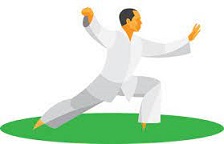The Art of Tai Chi: A Path to Harmony and Health
Movement is a fundamental characteristic of all living beings. As humanity has evolved, movement has remained essential to life. Any physical activity that benefits health is known as "exercise". Over time, various forms of exercise have been developed, and their significance continues to grow.
Like all aspects of human culture, exercise has a rich history. Among the oldest known forms of exercise still practiced today is Tai Chi. If you ever visit China, you'll likely see people in parks performing slow, graceful martial arts movements in the mornings or evenings. This is Tai Chi, an ancient practice with deep roots in Chinese tradition.
Tai Chi is believed to have originated with the Taoist master and martial artist Zhang Sanfeng, but it was Yang Luchan who, in the 19th century, introduced it to the wider world. Rooted in Taoism, Tai Chi embodies the balance of Yin and Yang - the opposing forces that maintain harmony in the universe. According to Taoist philosophy, the human body mirrors the natural world: hair grows like trees, and blood flows like rivers. Just as nature requires balance, so does the human body. Many Taoists view Tai Chi as a way of practicing their philosophy.
Also known as "shadowboxing," Tai Chi serves multiple purposes: physical exercise, mental well-being, and self-defence training. Its history traces back centuries to influences from Buddhism and Confucianism. Originally an internal martial art (neijia) focused on personal growth, it later became recognized for its health benefits. The Chinese government eventually promoted Tai Chi as a form of exercise, shifting its emphasis away from martial arts and making it a national sport.
Different Styles of Tai Chi:
Tai Chi has evolved into several distinct styles, each with unique characteristics:
- Yang Style - The most widely practiced form, known for slow, smooth, and fluid movements.
- Chen Style - Alternates between slow movements and sudden, explosive ones.
- Wu Style - Features small, deliberate movements performed at a slow pace.
- Hao Style - Focuses on internal energy with subtle, almost imperceptible external movements.
Core Principles of Tai Chi:
Despite variations in style, all Tai Chi forms share common goals:
Move second, arrive first.
Control movement through stillness.
Overcome force with finesse.
Know yourself and your opponent.
Basic Principles of Tai Chi:
Tai Chi is considered an internal art, meaning mastery requires developing and utilizing internal energy. Here are some key principles:
Elevate the crown of your head and focus your energy there.
Relax your waist to guide body movement.
Correct your chest and back position to lighten your lower body.
Differentiate between heaviness and lightness to understand weight distribution.
Relax your shoulders to promote energy flow.
Let your mind lead your body.
Unify the upper and lower body for coordinated movement.
Breathe deeply from your lower abdomen to synchronize mind, body, and breath.
Maintain harmony and fluidity; avoid breaking the flow of movement.
Seek stillness in motion to calm the mind.
The Spiritual Essence of Tai Chi:
Tai Chi is designed to engage both the body and the mind. However, if you approach it solely as a physical exercise, you may overlook its most profound benefits. As an ancient art, Tai Chi's deeper teachings were traditionally passed down orally from masters to students, preserving its secrets through generations. These masters left behind stories, riddles, and proverbs to help practitioners uncover the true essence of Tai Chi and harness its internal power.
To truly understand Tai Chi, one must:
Master the movements by understanding the philosophy behind them.
Move with intention - each motion has a specific purpose beyond just physical execution.
Perform the "Single Whip" move by engaging both hands and toes in a controlled motion.
Practice "White Crane Spreads Wings" by balancing your weight on one leg.
Enhance your balance with the "Pouring" technique.
Improve flexibility and control by doing arm circles with relaxed wrists and elbows extended forward.
Execute the "Snake Creeps Down" move, transitioning smoothly from a standing position into a deep, graceful lunge.
For beginners, it's recommended to start with the short form, consisting of 13 to 40 movements lasting 5 to 20 minutes. As you experience its benefits, you may find yourself drawn to practicing more.
How to Practice Tai Chi Effectively:
- Working face-to-face with an instructor is highly beneficial.
- Wear loose, comfortable clothing to allow free movement.
- Although Tai Chi appears gentle, it can build up a sweat, so avoid overdressing.
- T-shirts, leotards, and sweatpants work well for practice.
The Benefits of Tai Chi:
This non-competitive martial art is known for its gentle yet powerful impact on both the internal and external well-being of practitioners. Some of its proven benefits include:
Enhancing cognitive function in older adults.
Aiding in weight loss through regular practice.
Reducing the risk of falls by improving balance.
Lowering stress levels and improving mood.
Enhancing sleep quality through meditative movements.
Easing symptoms of fibromyalgia.
Improving strength and mobility in Parkinson's disease patients.
Alleviating arthritis pain through slow, controlled movements.
Tai Chi: A Journey to Inner Peace:
"The purpose of training is to tighten up the slack, toughen the body, and polish the spirit." - Morihei Ueshiba.
Tai Chi embodies this philosophy, serving as a bridge between the physical and spiritual. At its core, it fosters a deep connection between the mind and the body, linking one's inner and outer worlds. Its slow, fluid movements encourage mindfulness, heightening awareness of every part of the body. Through this practice, you gradually learn to accept your body's truths, let go of distractions, and cultivate neutrality. As a result, Tai Chi not only enhances personal well-being but also fosters a greater sense of harmony with the world around you.
Tai Chi may not be easy for everyone to grasp at first, but once you do, it can become an essential part of your life. One of its most appealing aspects is its non-competitive nature, making it a favourite among practitioners. In today's fast-paced, competitive world, Tai Chi offers a sanctuary of peace, joy, and balance. Its slow, meditative movements have a healing effect, soothing the heart and mind. It provides a space where you can rediscover harmony and tranquility, something often lost in the rush of modern life.
Important Considerations Before Practicing Tai Chi:
If you are pregnant, have a hernia, or suffer from joint/muscle conditions, consult a doctor before starting.
Since Tai Chi is a refined martial art, learning from a skilled instructor ensures proper technique and maximum benefits.
Once you're ready, step into the world of Tai Chi and experience its transformative power!
|

